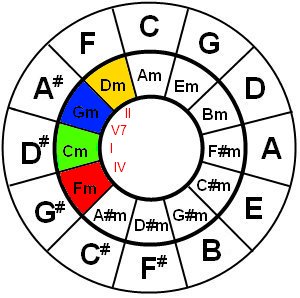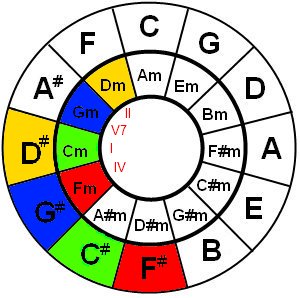Lesson 02: ‘Blue Bossa’
The second song we are going to have a look at is called “Blue Bossa”. “Blue Bossa” was written by Kenny Dorham and appeared for the first time on Joe Henderson’s album ‘Page One’ in 1963. Many artists made their version and I think all jazz musicians once in their life have played this song.
On youtube you can find many examples from jazz greats like
Cedar Walton:
Joe Henderson:
Dexter Gordon:
The chord progression of “Blue Bossa” is as follows:
Cm7 | Cm7 | Fm7 | Fm7 |
Dm7b5 | G7 | Cm7 | Cm7 |
Ebm7 | G#7 | C#Maj7 | C# Maj7|
Dm7b5 | G7 | Cm7 | Dm7b5 | G7 |
So the song consists of 7 different chords:

Chords for “Blue Bossa”All chords are standard and should be part of your mental chord-library except maybe for the Dm7b5. W’ll get into that one later.
Best is to first get to used to the song, play the midi file and try to play the chords.
The song starts off with the Cm7, so we can assume that the song is in C-minor. Looking at the inner (minor) circle of the circle of fifths, we see the following structure:

According to the circle of fifths, in C-minor (since we play Jazz, we play 7th chords):
- Cm7 is the i (tonic or root)
- G7 is the V7 (dominant)
- Fm7 is the iv (subdominant)
- Dm is the ii (supertonic)
This is a ii-V-I progression, the standard jazz progression, but now in minor.
Let’s have a look at the C-minor scale, it has the following notes (based upon the natural minor scale formula Whole-Half-Whole-W-H-W-W)
C-D-Eb-F-G-G#-A#-C
This gives the following chord structure:
- Tonic (formula 1-3-5-7 starting on the root): C-Eb-G-C# or the Cm7
- Dominant (formula 1-3-5-7 starting on the 5th): G-A#-D-F or the Gm7
- Subdominant (formula 1-3-5-7 starting on the 4th): F-G#-C-Eb or the Fm7
- Supertonic (formula 1-3-5-7 starting on the 2nd): D-F-G#-C or the Dm7b5
The only exception to the rule is the dominant, this is a G7 in the song instead of a Gm7 as the formula says. Of course, you could also play a Gm7 (give it a try yourself) but the G7 is much stronger here, it leads you really to ‘home’ to the tonic as a real dominant chord should do. And the rule is ‘if it sounds good, it is good!’.
Then we see a deviation in the chord sequence, we call this a modulation. The song modulates to Db. How does that work? Looking at the circle of fifths you can see that the song “jumps” from the inner ring (minor) the outer ring (major) by jumping from C minor to D# (or Eb) major (the inner green box to outer yellow box):

This happens a lot in all kinds of music, it’s not restricted to jazz.
The D# functions as the ii in the ii-VI-I progression of C# (or Db).
Once again the theory around Db (C#):
- Tonic (I) is Db
- Dominant (V7) is Ab7
- Supertonic (ii) is Ebm7
So the song jumps from C (inner ring) to the D# (outer ring). This D# is the ii in the ii-VI-I progression where C# is the I.
After this short modulation, the song jumps to back to the original C minor progression (ii-VI-I minor progression which is Dm7b5 | G7 | Cm7) and then has what we call a “turn-around”, playing the Dm7b5 en the G7 at the end before going to the beginning.
How did I know that the song modulated to Db and not the for example Eb? Well, from looking at the other chords, tonic Db seems more logical compared to a Eb tonic. And when we are going to solo, you’ll see that a Db major scale sounds best. So theory can’t help me here, it’s just listening what sounds good and the theory will fit in later, although I’m sure someone could explain perfectly from the theory that the song modulates to Db.
I always find it useful to play the melody on the guitar. Give it a try and you will notice that the melody is just the C-minor scale starting from G for 7 notes (to G#) to go back to the first note played (G) and the second (F). Then the next phrase starts at the second note (F) to go to the 7th note (G) and back to F-Eb. Then start start at Eb etc.
See how simple a strong melody can be. It just goes up the scale and the timing makes all the difference.
As we just saw, the song consists of a C-minor part, then a Db major part and then a C-minor part. So it is very easy to play:
- C-minor scale over the C-minor part
- Db-major scale over the Db-major part
These scales are also know as the C-Aeolian and the D-Ionian scales. They contain the following notes:
- C-Aeolian: C-D-Eb-F-G-G#-A#-C
- Db-Ionian: Db-Eb-Fb-Gb-Ab-A-Cb-Db
So we should learn these two scales now:
I have depicted the two scales in two shapes.


The first one, the C-Aeolian might appear familiar. Have a look at the previous lesson (“So What”) and the D-Dorian. You see the shapes are the same only the root is on another note. Please carefully study what is exactly different (also the position of the shapes differ). You will see that a lot when studying scale shapes, the overall shape is the same but the function of the notes (such as the “R”oot) differ.
Db-Ionian is a completely new shape. But if you have been playing guitar for a couple of years, the “green” shape should look familiar to you. It’s the standard “major” shape so Db-Ionian is also called Db major. Also for this scale, the shape with the root on the low E string and the shape with the root on the A-string.
You can always go back to play pentatonic, although the goal of this course is to learn more advanced scales. For this song, you can always rely on the C-pentatonic scale for the C-minor part and the B-pentatonic for the Db-major part.
So far the theory. Below I worked out a solo that makes use of these scales but it also does something else, it uses “broken-up” chords also known as “arpeggios”. So instead of strumming a chord you can also play each note of a chord one-by-one.
There are a lot of arpeggio shapes. I just introduced some of the most common shapes in this solo, but you can find a lot more on the web.
Good luck!
Dear Ed,
thank you for your instruction!
Just 2 comments:
1.:
In your Dm7b5-chord I am missing the b5-interval. Shouldn’t the g on string 1 be a g# ?
2.:
The Db-Ionian Scales are shown one fret to high.
With best regards
Manfred
Correct, I made some big mistakes in the diagrams, they’re fixed now.
Thanks for noticing!
Ed
Hello,
I think I may have spotted a mistake in the fretboard diagram. It seems like the “Db Ionian” examples (yellow and green dots) are centered around D major, not Db major. Thanks for sharing your advice. The rest was really helpful.
Correct, I have fixed it.
Thanks!
Ed
The yellow Green Tab scale is D or Db ?
Chord diagramm about Dm7b5 is wrong!
x33533 <-Frets
x737R4 <-Function
see the 4 needs to be a b5 so make the g on the e-string to a a-Flat.
So that will be (theoretically) correct:
x33534
But anyway beside variations this voicing still sounds strange to me.
Just play it the this:
x5656x
to make it flow.
^-btw I this is the standard 7b5 shape for the A string.
Thanks, fixed it. I’ll take the other shape into consideration, I wanted the chord shape to be as simple as possible but your alternative makes also good sense.
Regards,
Ed